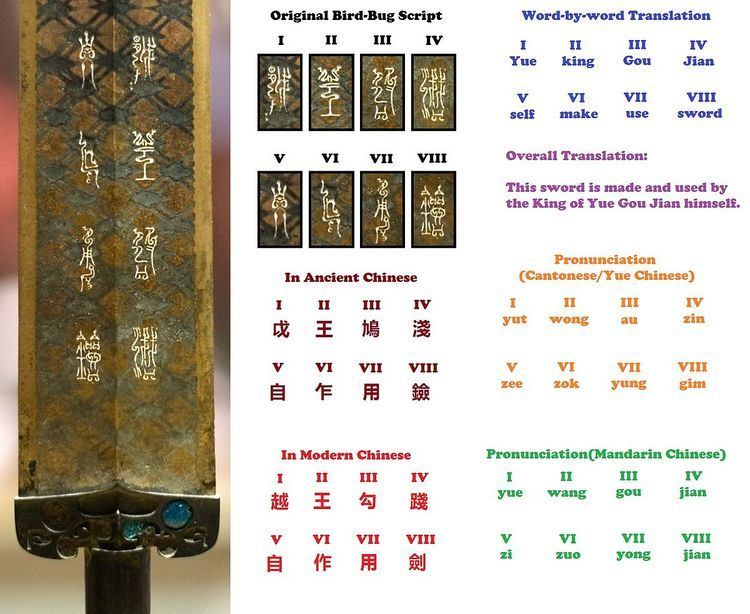Type Logographic script Creator Wu | Languages Chinese, Chu Created c. 771–476 BC | |
 | ||
Published (Date published - for shorthands and script reforms) Time period | ||
Bird-worm seal script (Simplified Chinese: 鸟虫篆; Traditional Chinese: 鳥蟲篆; Pinyin: Niǎo Chóng Zhuàn) is a type of ancient seal script originated in China.
Contents
Names
The Chinese character "鸟" (or "鳥" in traditional Chinese, and "Niǎo" in Pinyin) means "bird". The Chinese character "虫" (or "蟲" in traditional Chinese, and "Chóng" in Pinyin) means any creature that looks like a "worm", including invertebrate worms and reptiles such as snakes and lizards (and even the Chinese dragon). The character "篆" means "seal script".
Other names for this kind of seal script:
There are two subcategories (sub-styles):
Introduction and history
Seal script evolved from Oracle Bone Script, and diverged into different forms in the Spring and Autumn period, after the power of the Zhou dynasty waned and China began to divide into different states.
This kind of seal script first appeared in the middle era of the Spring and Autumn period. It then became popular during the late Spring and Autumn period, and was most popular during the Warring States period. It was often seen in southern kingdoms, such as the Wu Kingdom (roughly today's Jiangsu Province), Yue Kingdom (roughly today's Zhejiang Province), Chu Kingdom (roughly today's Hunan and Hubei provinces), Cai Kingdom, Xu Kingdom, and the Song Kingdom. Each state in China during the Warring States Period had its own variety of script.
These kinds of seal script declined after the Qin Dynasty, most likely due to the unification of writing scripts by Qin Shi Huang (unified into the small seal script), after his unification of China, although they were used during the Han Dynasty.
Usage
The bird seal script is often seen on bronze and iron antiques of the Yue Kingdom (roughly today's Zhejiang Province). The script was used on bronze and iron weapons, like swords, to indicate ownership or date of completion. The characters engraved on the famous Sword of Goujian provide a fine example. A few examples of the bird seal script can be seen in or on containers and jades of that period. The bird seal script was also used occasionally in the Han Dynasty seals (mainly the jade seals), as well as a few eaves tiles and bricks.
The worm seal script is more common, and probably originated from the Wu Kingdom (now roughly Jiangsu Province) or Chu Kingdom (now roughly Hunan Province and Hubei Province). Examples can be seen on antique bronze weapons, containers, jades, and seals (mainly the bronze seals of Han Dynasty), and constructional or decorative parts like tiles, etc. The characters on the famous Spear of Fuchai would be a good example of this category of seal script.
